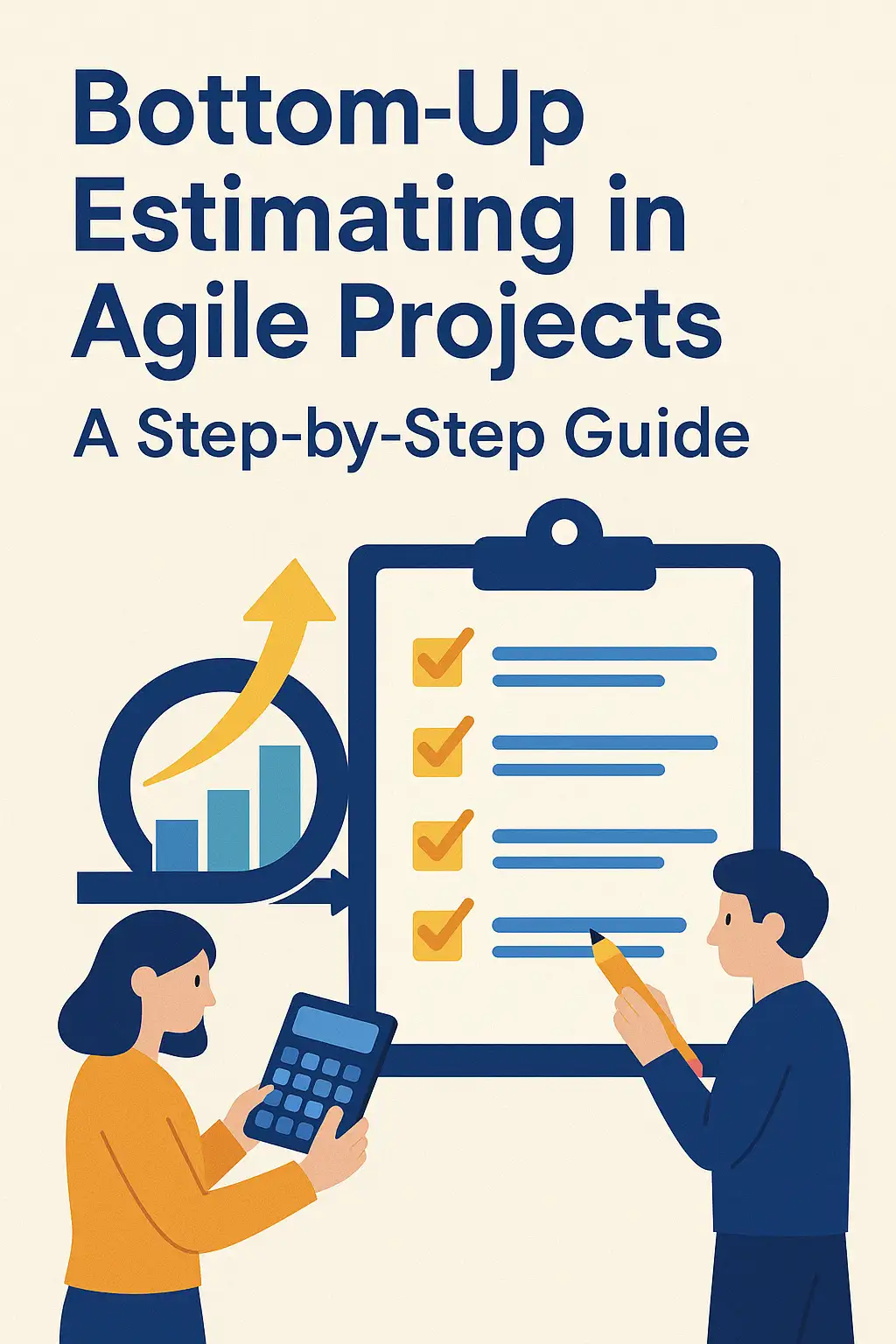Introduction to Bottom-Up Estimating
Bottom-up estimating is a project management technique that involves estimating the costs, durations, and resource requirements of a project at a granular level. This method starts by breaking down the project into its smallest components, such as individual tasks or work packages, and assessing each one for its specific needs. The estimates for these smaller tasks are then aggregated to form a comprehensive estimate for the entire project. This approach is particularly valuable in Agile environments, where flexibility and adaptability are paramount [10][15].
Agile methodologies, such as Scrum and Kanban, emphasize iterative development and responsiveness to change. These frameworks allow teams to adapt their plans based on feedback and evolving project requirements. The flexibility inherent in Agile practices means that accurate estimation is crucial; it helps teams allocate resources effectively, manage stakeholder expectations, and maintain project momentum. Inaccurate estimates can lead to resource shortages, missed deadlines, and ultimately, project failure [3][11].
Accurate estimation in Agile projects is essential for several reasons:
- Resource Allocation: Proper estimates enable project managers to allocate resources efficiently, ensuring that team members are not overburdened or underutilized [13].
- Stakeholder Communication: Clear and accurate estimates foster better communication with stakeholders, helping to set realistic expectations and build trust [11].
- Risk Management: By understanding the time and resources required for each task, teams can identify potential risks early and develop strategies to mitigate them [12].
Benefits of Bottom-Up Estimating in Agile
Bottom-up estimating is a powerful technique in project management, particularly within Agile frameworks. This method involves breaking down a project into smaller, manageable components and estimating the time and cost for each task individually. Here are some key benefits of implementing bottom-up estimating in Agile workflows:
- Improved Accuracy in Time and Cost Estimates: By assessing each task individually, bottom-up estimating allows for a more precise understanding of the resources required for each component of the project. This detailed approach helps in identifying dependencies and potential bottlenecks, leading to more reliable overall project estimates. The accuracy of bottom-up estimates is often superior to other methods, as it considers the unique complexities of each task [1][4][8].
- Enhanced Team Collaboration and Ownership: This estimating technique fosters greater collaboration among team members. As each team member contributes to the estimation of their respective tasks, it encourages ownership and accountability. Team members are more likely to engage in discussions about the work involved, share insights, and provide input based on their expertise, which can lead to a more cohesive team dynamic and improved project outcomes [2][5][6].
- Greater Adaptability to Changes in Project Scope: Agile projects are inherently dynamic, with requirements often evolving throughout the project lifecycle. Bottom-up estimating allows teams to quickly reassess and adjust their estimates as changes occur. Since each task is evaluated independently, it becomes easier to adapt to new information or shifts in project scope without losing sight of the overall project goals [3][4][9].
Preparing for Bottom-Up Estimating
Implementing bottom-up estimating in Agile projects requires careful preparation to ensure accuracy and effectiveness. Here are the essential steps Agile project managers should take before diving into the estimating process:
1. Gathering Project Requirements and Scope
Before any estimation can take place, it is crucial to have a clear understanding of the project requirements and scope. This involves:
- Defining Objectives: Clearly outline the goals of the project to ensure that all team members are aligned on what needs to be achieved.
- Documenting Requirements: Collect detailed requirements from stakeholders, ensuring that every aspect of the project is captured. This may include functional and non-functional requirements, user stories, and acceptance criteria.
- Establishing Boundaries: Determine what is included in the project scope and what is not, to avoid scope creep during the estimation process. This clarity helps in accurately estimating the time and resources needed for each task.
2. Assembling a Cross-Functional Team for Estimations
A successful bottom-up estimating process relies on the collaboration of a diverse team. To prepare effectively:
- Select Team Members: Assemble a cross-functional team that includes representatives from various disciplines such as development, design, quality assurance, and product management. This diversity ensures that all perspectives are considered during the estimation process.
- Encourage Collaboration: Foster an environment where team members feel comfortable sharing their insights and expertise. This collaboration can lead to more accurate estimates as different viewpoints are integrated into the planning.
- Facilitate Communication: Establish clear communication channels among team members to streamline discussions and ensure that everyone is on the same page regarding project requirements and tasks.
3. Identifying Key Tasks and Deliverables
Once the project requirements are gathered and the team is assembled, the next step is to break down the project into manageable components:
- Decompose the Project: Start by identifying all key tasks and deliverables required to meet the project objectives. This involves breaking down larger tasks into smaller, actionable items that can be estimated individually.
- Create a Work Breakdown Structure (WBS): Develop a Work Breakdown Structure to visually represent the hierarchy of tasks and deliverables. This structure helps in organizing the project and ensures that no critical components are overlooked.
- Prioritize Tasks: Determine the priority of each task based on its importance and dependencies. This prioritization will guide the team in focusing on the most critical elements during the estimation process.
By following these preparatory steps, Agile project managers can set a solid foundation for implementing bottom-up estimating. This approach not only enhances the accuracy of estimates but also aligns the team towards a common goal, ultimately leading to more successful project outcomes.
Step-by-Step Guide to Implementing Bottom-Up Estimating
Bottom-up estimating is a powerful technique in project management, particularly within Agile frameworks, where accuracy and team involvement are crucial. This guide outlines practical steps for Agile project managers to effectively implement bottom-up estimating in their workflows.
Step 1: Break Down the Project into Smaller, Manageable Tasks
The first step in bottom-up estimating is to decompose the project into its smallest components. This involves creating a Work Breakdown Structure (WBS) that details every task or work package necessary to complete the project. By breaking the project down, you ensure that no detail is overlooked, which is essential for accurate estimation [6][11].
Step 2: Engage the Team to Estimate Each Task
Once the tasks are identified, the next step is to involve the team in estimating the effort required for each task. Techniques such as Planning Poker can be particularly effective in this phase. This collaborative approach not only leverages the collective knowledge of the team but also fosters a sense of ownership and accountability among team members [10][15]. Each team member can provide their input, leading to a more comprehensive understanding of the work involved.
Step 3: Compile Individual Estimates into an Overall Project Estimate
After gathering estimates for each task, the next step is to aggregate these individual estimates to form a comprehensive project estimate. This involves summing up the time, cost, and resources required for all tasks to arrive at a total estimate for the project. This aggregation is crucial as it provides a clear picture of the overall project scope and resource requirements [12][14].
Step 4: Validate Estimates Through Team Discussions and Adjustments
Validation of the compiled estimates is essential to ensure their accuracy. This can be achieved through team discussions where members can challenge and refine the estimates based on their insights and experiences. Adjustments may be necessary to account for any discrepancies or new information that arises during these discussions. This step not only enhances the accuracy of the estimates but also reinforces team collaboration [5][11].
Step 5: Document Assumptions and Risks Associated with Estimates
Finally, it is important to document any assumptions made during the estimating process, as well as potential risks that could impact the estimates. This documentation serves as a reference point for the team and stakeholders, providing clarity on the basis of the estimates and highlighting areas that may require further attention or monitoring throughout the project lifecycle [4][12].
By following these steps, Agile project managers can effectively implement bottom-up estimating, leading to more accurate project planning and execution. This method not only enhances the reliability of estimates but also promotes team engagement and accountability, which are vital in Agile environments.
Tools and Techniques for Bottom-Up Estimating
Bottom-up estimating is a crucial technique in Agile project management that allows teams to create detailed and accurate estimates by breaking down projects into smaller, manageable tasks. This section will explore various tools and techniques that facilitate effective bottom-up estimating, ensuring Agile project managers can implement this method seamlessly in their workflows.
Overview of Agile Estimation Tools
Agile estimation tools are designed to help teams manage their projects efficiently while providing a framework for accurate task estimation. Some popular tools include:
- Jira: A widely used project management tool that supports Agile methodologies. Jira allows teams to create detailed task breakdowns, assign story points, and track progress, making it easier to implement bottom-up estimating effectively [6][12].
- Trello: This visual project management tool uses boards and cards to organize tasks. Trello can be customized to include estimation features, allowing teams to estimate time and effort for each task visually [10].
- Wrike: Another project management tool that enables users to create robust bottom-up estimates. Wrike allows teams to estimate time requirements for individual tasks and aggregate them for a comprehensive project overview [3][7].
Techniques for Task Estimation
Implementing effective task estimation techniques is essential for accurate bottom-up estimating. Here are some commonly used methods:
- T-shirt Sizing: This technique categorizes tasks into sizes (XS, S, M, L, XL) based on their complexity and effort required. It provides a quick way to estimate tasks without getting bogged down in details, making it ideal for early project phases [15].
- Fibonacci Sequence: This method uses a numerical sequence (1, 2, 3, 5, 8, 13, etc.) to assign story points to tasks. The Fibonacci sequence helps teams express the relative effort required for tasks, allowing for more nuanced estimates as complexity increases [15].
- Three-Point Estimation: This technique involves estimating the best-case, worst-case, and most likely scenarios for each task. By averaging these estimates, teams can arrive at a more balanced and realistic estimate [8].
Importance of Using Historical Data
Utilizing historical data is vital for improving the accuracy of estimates in bottom-up estimating. By analyzing past project data, Agile project managers can:
- Identify Patterns: Historical data can reveal trends in task completion times and resource allocation, helping teams make informed estimates based on real-world performance [11].
- Refine Estimates: By comparing new tasks with similar past tasks, teams can adjust their estimates to reflect actual performance, leading to more reliable planning [10].
- Enhance Team Confidence: When teams see that their estimates are based on historical data, it fosters confidence in the planning process and encourages accountability among team members [11].
Common Challenges and Solutions
Bottom-up estimating is a valuable technique in Agile project management, allowing teams to break down projects into smaller, manageable components. However, this approach can present several challenges that Agile project managers must navigate effectively. Below are some common challenges along with practical solutions to enhance the bottom-up estimating process.
1. Identifying and Mitigating Biases in Estimations
Challenge: One of the most prevalent issues in estimation is optimism bias, where team members tend to underestimate the time and resources required for tasks. This can lead to unrealistic timelines and budget overruns.
Solution:
- Awareness and Training: Educate the team about common biases, including optimism bias, and encourage them to critically assess their estimates. Workshops or training sessions can help in recognizing these biases.
- Historical Data Review: Utilize historical data from previous projects to provide a reality check against current estimates. This can help ground expectations and provide a more accurate basis for future estimations [5].
- Incorporate Buffer Time: Encourage the inclusion of buffer time in estimates to account for unforeseen challenges. This can help mitigate the impact of underestimations and provide a cushion for project timelines.
2. Managing Team Dynamics and Differing Opinions
Challenge: In a collaborative environment, differing opinions on task estimates can lead to conflicts and hinder the decision-making process. Team dynamics can be affected if some members dominate discussions while others remain silent.
Solution:
- Structured Estimation Techniques: Implement structured estimation techniques such as Planning Poker or Affinity Grouping. These methods promote equal participation and help in reaching a consensus by allowing team members to express their views anonymously before discussing them as a group [7].
- Facilitated Discussions: Designate a facilitator to guide discussions during estimation sessions. This person can ensure that all voices are heard and that the conversation remains productive, helping to balance differing opinions and reduce tension [2].
- Regular Check-Ins: Conduct regular check-ins to address any ongoing conflicts or concerns within the team. This can foster a more open environment where team members feel comfortable sharing their thoughts.
3. Ensuring All Team Members Participate in the Estimation Process
Challenge: Ensuring that all team members contribute to the estimation process can be difficult, especially if some individuals are less vocal or confident in their expertise.
Solution:
- Encourage Inclusivity: Create an inclusive atmosphere where every team member feels valued and encouraged to share their insights. This can be achieved by explicitly inviting quieter members to contribute during discussions.
- Use Anonymous Input Tools: Utilize tools that allow team members to submit their estimates anonymously before discussing them as a group. This can help reduce the pressure to conform to dominant voices and encourage honest input from everyone [10].
- Rotate Roles: Rotate roles within the team during estimation sessions, allowing different members to lead discussions or present their estimates. This can help build confidence and ensure diverse perspectives are considered.
By addressing these common challenges with practical solutions, Agile project managers can enhance the effectiveness of bottom-up estimating in their workflows. This approach not only improves the accuracy of project estimates but also fosters a collaborative team environment that is essential for successful Agile project management.
Real-World Examples of Bottom-Up Estimating in Agile
Bottom-up estimating is a crucial technique in Agile project management that allows teams to break down projects into smaller, manageable components. This method not only enhances accuracy in time and cost predictions but also fosters a deeper understanding of the project scope. Here, we explore a case study of a successful Agile project utilizing bottom-up estimating, lessons learned from challenges faced, and best practices derived from real-world applications.
Case Study: Wedding Cake Bakery Project
A practical example of bottom-up estimating can be seen in a wedding cake bakery project. The bakery team used this approach to calculate the cost of producing a custom wedding cake. They began by breaking down the project into smaller tasks, such as:
- Ingredient Sourcing: Estimating the cost of flour, sugar, eggs, and other ingredients.
- Labor: Calculating the time required for baking, decorating, and assembling the cake.
- Delivery: Estimating the logistics involved in transporting the cake to the venue.
By aggregating these granular estimates, the bakery was able to provide an accurate total cost and timeline for the project, ensuring that they met client expectations while effectively managing resources [4][7].
Lessons Learned from Challenges
While bottom-up estimating can lead to successful outcomes, it is not without its challenges. For instance, the Sydney Opera House project serves as a cautionary tale. Poor initial estimations led to significant budget overruns and delays. Key lessons learned from such projects include:
- Importance of Accurate Estimations: Inaccurate estimations can derail projects, highlighting the need for thorough analysis at the granular level [3].
- Continuous Review and Adjustment: Agile projects require flexibility; teams must be prepared to revisit and adjust estimates as new information becomes available or project scopes change.
These experiences underscore the necessity of diligent planning and the potential pitfalls of neglecting detailed estimations.
Best Practices for Implementing Bottom-Up Estimating
To maximize the effectiveness of bottom-up estimating in Agile workflows, consider the following best practices:
- Engage the Entire Team: Involve all team members in the estimation process to leverage diverse insights and expertise. This collaborative approach can lead to more accurate estimates and foster team ownership of the project [2].
- Use Historical Data: Reference past projects to inform current estimates. Historical data can provide valuable benchmarks and help identify potential risks [8].
- Iterate and Refine: Treat estimates as living documents. Regularly revisit and refine estimates based on ongoing project developments and feedback [9].
- Focus on Communication: Maintain open lines of communication among team members and stakeholders to ensure everyone is aligned on project goals and expectations [10].
By applying these best practices, Agile project managers can enhance their bottom-up estimating processes, leading to more successful project outcomes and improved team dynamics.
Conclusion
Bottom-up estimating emerges as a vital technique that enhances accuracy and fosters team collaboration. By breaking down projects into smaller, manageable tasks, Agile project managers can achieve a more precise understanding of the time, cost, and resources required for successful project completion. This method not only improves the reliability of estimates but also empowers team members to contribute their insights, leading to a more engaged and motivated workforce.
Key Benefits of Bottom-Up Estimating:
- Accuracy: This approach allows for detailed assessments at the granular level, which significantly reduces the risk of underestimating project requirements. Each task is evaluated individually, ensuring that all aspects of the project are considered [6][11].
- Enhanced Collaboration: By involving team members in the estimation process, bottom-up estimating cultivates a culture of transparency and collaboration. Team members can share their expertise and insights, leading to more informed decision-making and a stronger sense of ownership over the project [15].
- Risk Mitigation: With a comprehensive understanding of the project scope from the outset, managers can identify potential issues early on, allowing for proactive adjustments and resource allocation [15].
As Agile project managers, embracing bottom-up estimating can transform your project planning and execution. It encourages a collaborative environment where team members feel valued and empowered to contribute to the project’s success.
Find out more about Shaun Stoltz https://www.shaunstoltz.com/about/.
This post was written by an AI and reviewed/edited by a human.



